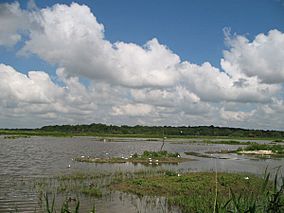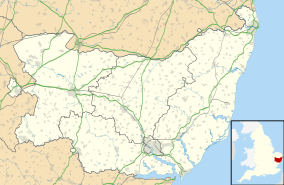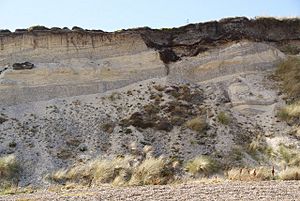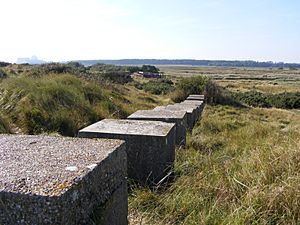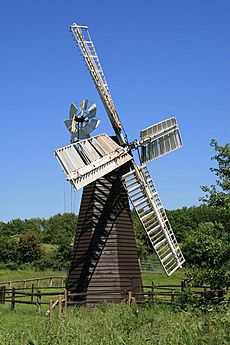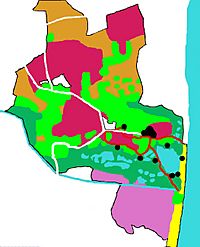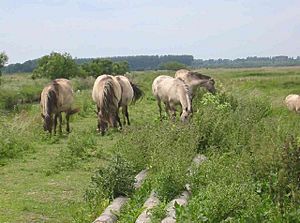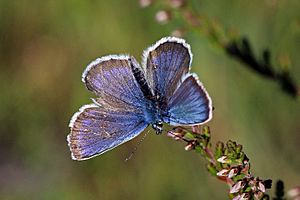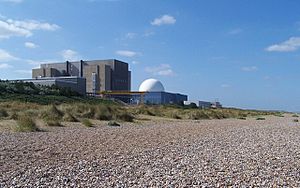RSPB Minsmere facts for kids
RSPB Minsmere is a special place in Suffolk, England. It is a nature reserve looked after by the Royal Society for the Protection of Birds (RSPB). The RSPB has managed this area since 1947.
Minsmere is about 1,000 hectares (2,500 acres) in size. It has many different natural areas. You can find reed beds, open heathland, grassy fields, woodlands, and shingle areas. It is part of a beautiful area called the Suffolk Coast and Heaths Area of Outstanding Natural Beauty.
This reserve is mainly managed to help birds. It protects rare breeding birds like the bittern and stone-curlew. Many other animals and plants also live here because of the different habitats.
Before it became a nature reserve, Minsmere had an old abbey and a fort from the Tudor times. The marshy areas were used for farming in the 1800s. But they were flooded again during World War II to help protect the coast.
Today, Minsmere has a visitor centre and eight bird hides. There are also many paths for walking. It is a great place to learn about nature and see amazing wildlife.
Contents
The Landscape of Minsmere
Minsmere is located near the wide valley of the Minsmere River. To the north are the Dunwich cliffs, and to the south are the Sizewell cliffs. The beach here has sand and shingle.
The cliffs can be up to about 17 metres (56 feet) high. They are eroding, or wearing away, quite quickly. About 1 to 2 metres (3 to 7 feet) of cliff disappear each year.
Long ago, from 500 BC to 700 AD, the sea level in Suffolk was much higher. The low areas of the coast were then tidal rivers. The river mouth closed in the 1700s as sand and shingle built up. The higher land is made of gravel and sand from an ancient beach. The soil in the wet areas is mostly clay from the sea and freshwater mud from the Minsmere River.
Minsmere's Past
Early History and the Abbey
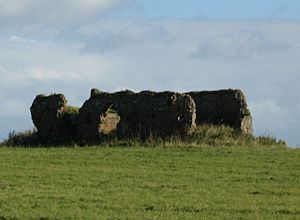
In 1086, Minsmere was known as Menesmara or Milsemere. It was a small village with six families.
In 1182, an abbey was built on the marshes at Minsmere. The area was protected by banks to keep the sea out and create farmland. But the abbey still suffered from floods. In 1363, the monks moved inland and used the stones to build Leiston Abbey.
Today, you can still see the ruins of the chapel of St Mary. This chapel was built inside the old abbey church. During World War II, a small concrete fort (a pillbox) was built inside the chapel. These ruins are now a protected historical site.
People also cut peat (a type of fuel) at Minsmere from the 1100s. In 1237, Minsmere was even described as a port. In the 1500s, a fort with cannons was built at Minsmere to protect the coast. Later, in the 1840s, a coastguard station was here to stop smuggling.
Farming and Flooding
Around 1780, a sandbank blocked the Minsmere River. This created a large freshwater wetland. People cut the reeds for thatching roofs. In the early 1800s, the marshes were drained for farming. A main sluice (a gate to control water flow) was built to let water out to the sea. A new canal, called the New Cut, was also built to help with drainage and transport.
There were also windmills on the levels. These windmills were used to pump water away from the fields. One of them, the Eastbridge Windpump, worked until 1939. Its remains were saved and rebuilt at the Museum of East Anglian Life in Stowmarket.
During World War II, the marshes were flooded again on purpose. This was to help defend against a possible invasion along the coast. Many military defenses were built, like pillboxes and anti-tank blocks. The British Army also used the heathland for training.
Before the war, a family called Ogilvie owned the land. They used it for farming and hunting. After the war, they decided not to drain the marshes again. They saw how valuable the area was for birds.
The RSPB Takes Over
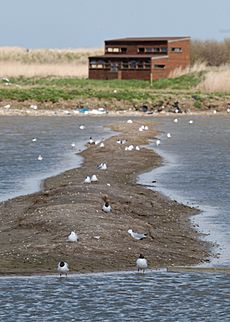
The RSPB had been interested in Minsmere since the late 1930s. In 1947, they signed an agreement to manage the site. In 1959, a warden named Bert Axell made big changes. He understood that natural plant growth would change important habitats.
He created the "scrape," an area with shallow water, islands, and bare mud. He did this by lowering the land and controlling the water level with new sluices. This created perfect conditions for many birds. In 1977, the RSPB bought the reserve completely.
A big storm in 1987 destroyed many trees. Some areas were replanted, but others were turned into heathland. This helped birds like woodlarks.
Minsmere is very important for bitterns. These birds were in serious decline in the UK. By managing the reed beds and creating new pools, Minsmere helped the bittern population grow. The reserve now covers about 1,000 hectares of different habitats. It is protected by several important laws and designations.
Visiting Minsmere
You can reach Minsmere by car from the A12 road. It is also connected to national and regional cycle routes. The nearest bus stop is in Leiston, and the nearest train station is in Darsham. You can also walk to Minsmere from nearby areas like Dunwich Heath. There are about 19 km (12 miles) of public paths around the reserve.
Minsmere was first set up to protect rare breeding birds. For a long time, you needed a special permit to visit. But since 2005, Minsmere has been open every day.
The visitor centre was built in 1996 and made bigger in 2012. It has a café, shop, and toilets. You can also rent binoculars or get children's 'explorer packs'. Entry is free for RSPB members, but non-members pay a fee. The reserve is open from dawn to dusk. The visitor centre has specific opening hours. Only assistance dogs are allowed inside the reserve buildings and trails.
Minsmere has been shown on BBC TV shows like Birdwatch and Springwatch.
How Minsmere is Managed
The main goal at Minsmere is to keep the wetland, heathland, and grassland healthy. Water levels are controlled using sluices. These gates help keep seawater out of the reed beds and manage water in the scrape.
Vegetation is removed from the lagoons each year. Parts of the scrape are dried out and reflooded every five years. An electric fence protects the scrape from predators like badgers. This helps ground-nesting birds.
Konik horses and Highland cattle graze the reed beds when they are drained. This helps keep the reed beds healthy and creates open pools for bitterns to feed in.
The heathland and grassy areas are managed by grazing animals. They also remove unwanted trees and plants like gorse. Some areas of gorse are cut in rotation to keep them short. This is good for birds like nightingales.
In 1989, the RSPB bought more farmland. They changed this land into heathland to help threatened birds like the stone-curlew and nightjar. They made the soil more acidic and planted new plants.
Animals and Plants at Minsmere
Minsmere is a very large reserve with many different habitats. This makes it a home for many animals and plants. About 5,800 different species have been found here!
Birds
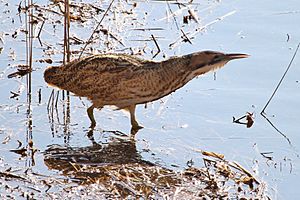
As of 2017, 342 types of birds have been seen at Minsmere. More than 100 of these have bred here. The bittern population has grown a lot thanks to Minsmere's efforts. There are now 9-12 booming male bitterns each year.
The stone curlew has also done well. Minsmere has created good nesting spots for them. The avocet first returned to Britain in 1947, with four pairs breeding at Minsmere. Now, 40 to 140 pairs breed here each year.
In 1971, Minsmere had the only nesting pair of marsh harriers in the UK. Other important birds include bearded tits, woodlarks, and nightjars. Nightingales live in the woodlands, and Dartford warblers have returned to the heaths.
Many wildfowl, like wigeon and teal, spend the winter at Minsmere. Strong winds can also bring rare migrant birds, such as bluethroats and wrynecks.
Minsmere's location on the east coast means it sees many rare birds. Recent sightings include Britain's first western swamphen in 2016 and a black-browed albatross in 2015.
Other Animals and Plants
Minsmere is home to about 300 red deer. You can also find otters, badgers, and water voles. The reserve works to protect water voles by controlling American mink. Other animals include adders (snakes) and natterjack toads. There are also 13 types of fish.
Over 1,000 types of moths and butterflies have been found at Minsmere. This includes a large group of silver-studded blue butterflies. Rare moths like the flame wainscot also live here. The reserve has also seen new insects like the European beewolf and the antlion.
Dead trees in the woodlands support many invertebrates and over 1,500 types of fungus. Some of these fungi are very rare. The shingle beaches have special plants like yellow horned-poppy.
Challenges for Minsmere
The Suffolk coast has always faced challenges from the sea. Towns like Dunwich, next to Minsmere, were lost to storms centuries ago. The big storm of 1953 also caused a lot of flooding.
Today, Minsmere faces threats from rising sea levels due to climate change. This can affect how the reserve drains water and lead to flooding. Coastal erosion also threatens the beach and the clay bank that protects the reserve. Experts think parts of the beach could be badly damaged within 20 years.
Another challenge is the plan to build new reactors at the nearby Sizewell nuclear power site. The RSPB is concerned that this construction could affect the water levels in the marshes. It could also change the coastline.
Any damage to Minsmere's wetlands could greatly affect the number of bitterns in the UK. This is because a large part of the national breeding population lives here.


